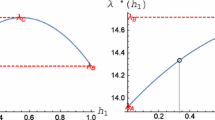Abstract
Science fiction and fantasy writer Vera Nazarian famously observed that “luck is not as random as you think. Before that lottery ticket won the jackpot someone had to buy it.” Many economic theorists have neglected that wisdom and mistakenly reduced the existence of clusters (defined as geographical concentrations of interconnected companies with close supply links, specialist suppliers, service providers, and related industries and institutions) to an almost banal phenomenon that randomly occurs whenever private firms gather by accident in someplace, start trading together, and eventually realize that it is more profitable even for competitors to stick together in a specific location. Clusters have thus been viewed merely as byproducts of economic development.
Access this chapter
Tax calculation will be finalised at checkout
Purchases are for personal use only
Preview
Unable to display preview. Download preview PDF.
Similar content being viewed by others
References
Aghion, P. (2009) Some Thoughts on Industrial Policy and Growth. Working Paper No. 2009–09 (Paris: OFCE-Sciences Po).
Arrow, K.J. (1962) “The Economic Implications of Learning by Doing,” Review of Economic Studies, vol. 29, pp. 155–172.
Chenggang, X. (2011) “The Fundamental Institutions of China’s Reforms and Development,” Journal of Economic Literature, vol. 49, no. 4, pp. 1076–1151.
David, P.A. (1985) “,” The American Economic Review, vol. 75, no. 2, Papers and Proceedings of the Ninety-Seventh Annual Meeting of the American Economic Association. (1985), pp. 332–337.
Faroie, T. (2011) Special Economie Zones in Africa: Comparing Performance and Learning from Global Experiences (Washington, D.C.: World Bank).
FIAS (2008) Special Economic Zones: Performance, Lessons Learned, and Implications for zone Development (Washington, DC: IFC-World Bank).
Griliches, Z., 1979. “Issues in Assessing the Contribution of R&D to Productivity Growth,” Bell Journal of Economics, vol. 10, pp. 92–116.
Harrison, A. and Rodriguez-Clare, A. (2010) “Trade, Foreign Investment, and Industrial Policy for Developing Countries” in D. Rodrik (ed.) Handbook of Economic Growth, vol. 5 (Amsterdam: North-Holland), pp. 4039–4213.
Imbs, J., and Wacziarg, R. (2003) “Stages of Diversification,” American Economic Review, vol. 93, no. 1, 63–86.
Krugman, P. (2008) “The Increasing Returns Revolution in Trade and Geography,” Nobel Prize Lecture, Oslo, December 8.
Krugman, P. (1994) Peddling Prosperity: Economic Sense and Nonsense in the Age of Diminished Expectations (New York: W.W. Norton and Co.).
Krugman, P.R. (1995) “Increasing Returns, Imperfect Competition, and the Positive Theory of International Trade,” in G.M. Grossman and K. Rogoff (eds), Handbook of International Economics, vol. 3 (Amsterdam: North-Holland).
Lin, J.Y. (2012a) New Structural Economics: A Framework for Rethinking Development and Policy (Washington, DC: World Bank).
Lin, J.Y. (2012b) The Quest for Prosperity: How Developing Countries Can Take Off (Princeton, NJ: Princeton University Press).
Lin, J.Y. and Monga, C. (2011) “Growth Identification and Facilitation: The Role of the State in the Dynamics of Structural Change,” Development Policy Review, vol. 29, no. 3, pp. 259–310.
Lyn, G., and Rodriguez-Clare, A. (2011) “Marshallian Externalities, Comparative Advantage, and International Trade,” mimeo, University of California Berkeley. Available online at http://emlab.berkeley.edu/~arodeml/Papers/LR_Marshallian_ Externarities_Trade.pdf.
Marshall, A. (1890) Principles of Economics (London: Macmillan).
Monga, C. (2011) Cluster-Based Industrial Parks. A Practical Framework for Action, Policy Research Working Paper no. 5900, December (Washington, DC: World Bank).
Paul, C.J. and Siegel, D.S. (1999) “Scale Economies and Industry Agglomeration Externalities: A Dynamic Cost Function Approach,” American Economic Review, vol. 89, pp. 272–290.
Rodriguez-Clare, A. (2005) Clusters and Comparative Advantage: Implications for Industrial Policy, Working Paper no. 523 (Washington, DC: Inter-American Development Bank).
Stiglitz, J.E. (2001) Information and the Change in the Paradigm in Economics, Nobel Prize Lecture, December 8.
World Bank (2009) World Development Report: Reshaping Economic Geography (Washington, DC: World Bank).
Zhang, X. (2012) “Clusters as an Instrument for Industrial Policy: The Case of China,” Paper presented at the International Economic Association (IEA) — World Bank Roundtable “New Thinking in Industrial Policy” at the World Bank, May.
Author information
Authors and Affiliations
Editor information
Editors and Affiliations
Copyright information
© 2013 International Economic Association
About this chapter
Cite this chapter
Monga, C. (2013). Theories of Agglomeration: Critical Analysis from a Policy Perspective. In: Stiglitz, J.E., Lin, J.Y. (eds) The Industrial Policy Revolution I. International Economic Association Series. Palgrave Macmillan, London. https://doi.org/10.1057/9781137335173_14
Download citation
DOI: https://doi.org/10.1057/9781137335173_14
Publisher Name: Palgrave Macmillan, London
Print ISBN: 978-1-137-37452-3
Online ISBN: 978-1-137-33517-3
eBook Packages: Palgrave Economics & Finance CollectionEconomics and Finance (R0)




